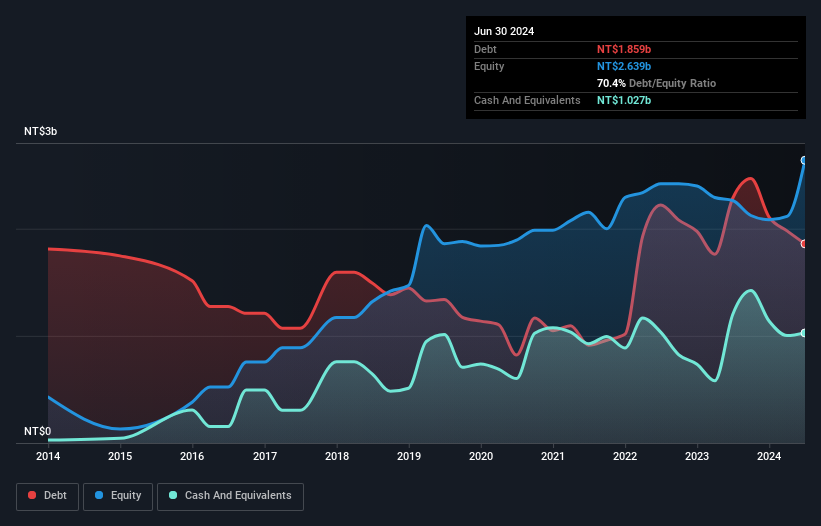Warren Buffett famously said, 'Volatility is far from synonymous with risk.' So it might be obvious that you need to consider debt, when you think about how risky any given stock is, because too much debt can sink a company. We note that RiTdisplay Corporation (TWSE:8104) does have debt on its balance sheet. But the more important question is: how much risk is that debt creating?
When Is Debt Dangerous?
Debt is a tool to help businesses grow, but if a business is incapable of paying off its lenders, then it exists at their mercy. If things get really bad, the lenders can take control of the business. However, a more common (but still painful) scenario is that it has to raise new equity capital at a low price, thus permanently diluting shareholders. Of course, plenty of companies use debt to fund growth, without any negative consequences. When we examine debt levels, we first consider both cash and debt levels, together.
Check out our latest analysis for RiTdisplay
What Is RiTdisplay's Debt?
You can click the graphic below for the historical numbers, but it shows that RiTdisplay had NT$1.86b of debt in June 2024, down from NT$2.28b, one year before. However, because it has a cash reserve of NT$1.03b, its net debt is less, at about NT$831.8m.

A Look At RiTdisplay's Liabilities
Zooming in on the latest balance sheet data, we can see that RiTdisplay had liabilities of NT$1.86b due within 12 months and liabilities of NT$735.4m due beyond that. On the other hand, it had cash of NT$1.03b and NT$619.7m worth of receivables due within a year. So it has liabilities totalling NT$946.1m more than its cash and near-term receivables, combined.
This deficit isn't so bad because RiTdisplay is worth NT$4.40b, and thus could probably raise enough capital to shore up its balance sheet, if the need arose. However, it is still worthwhile taking a close look at its ability to pay off debt. The balance sheet is clearly the area to focus on when you are analysing debt. But you can't view debt in total isolation; since RiTdisplay will need earnings to service that debt. So when considering debt, it's definitely worth looking at the earnings trend. Click here for an interactive snapshot.
Over 12 months, RiTdisplay made a loss at the EBIT level, and saw its revenue drop to NT$2.5b, which is a fall of 12%. We would much prefer see growth.
Caveat Emptor
While RiTdisplay's falling revenue is about as heartwarming as a wet blanket, arguably its earnings before interest and tax (EBIT) loss is even less appealing. Indeed, it lost NT$55m at the EBIT level. When we look at that and recall the liabilities on its balance sheet, relative to cash, it seems unwise to us for the company to have any debt. So we think its balance sheet is a little strained, though not beyond repair. We would feel better if it turned its trailing twelve month loss of NT$195m into a profit. So in short it's a really risky stock. When analysing debt levels, the balance sheet is the obvious place to start. However, not all investment risk resides within the balance sheet - far from it. These risks can be hard to spot. Every company has them, and we've spotted 3 warning signs for RiTdisplay (of which 1 is potentially serious!) you should know about.
Of course, if you're the type of investor who prefers buying stocks without the burden of debt, then don't hesitate to discover our exclusive list of net cash growth stocks, today.
New: AI Stock Screener & Alerts
Our new AI Stock Screener scans the market every day to uncover opportunities.
• Dividend Powerhouses (3%+ Yield)
• Undervalued Small Caps with Insider Buying
• High growth Tech and AI Companies
Or build your own from over 50 metrics.
Have feedback on this article? Concerned about the content? Get in touch with us directly. Alternatively, email editorial-team (at) simplywallst.com.
This article by Simply Wall St is general in nature. We provide commentary based on historical data and analyst forecasts only using an unbiased methodology and our articles are not intended to be financial advice. It does not constitute a recommendation to buy or sell any stock, and does not take account of your objectives, or your financial situation. We aim to bring you long-term focused analysis driven by fundamental data. Note that our analysis may not factor in the latest price-sensitive company announcements or qualitative material. Simply Wall St has no position in any stocks mentioned.
About TWSE:8104
RiTdisplay
Engages in the research, development, and manufacturing of PMOLED products in Taiwan and internationally.
Fair value with low risk.
Similar Companies
Market Insights
Community Narratives




